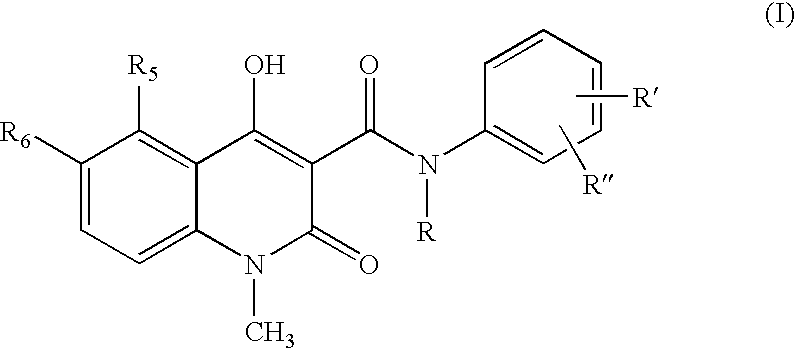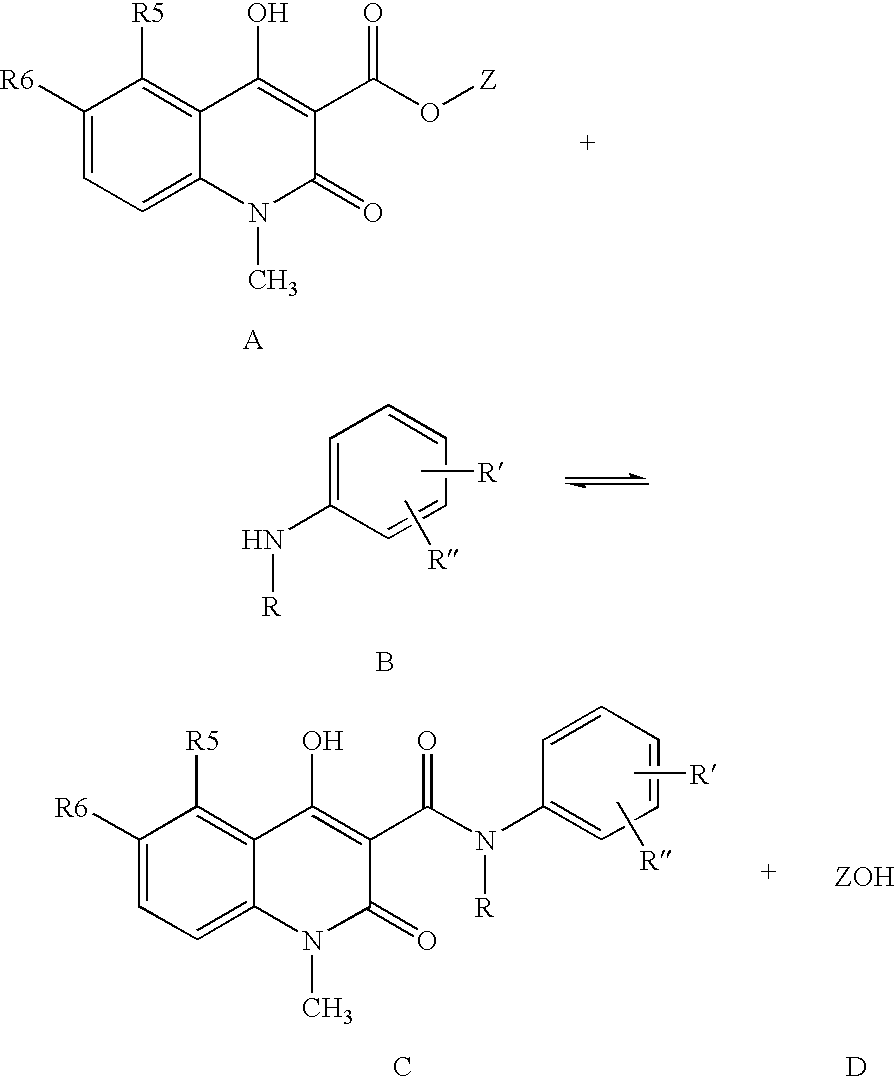Process for the manufacture of quinoline derivatives
a technology of quinoline and manufacturing process, which is applied in the field of process for the manufacturing of quinoline derivatives, can solve the problems of small amount of water in the reaction mixture, easy to react with water, and inability to dissolve desired produ
- Summary
- Abstract
- Description
- Claims
- Application Information
AI Technical Summary
Problems solved by technology
Method used
Image
Examples
example 1
1,2-Dihydro-4-hydroxy-5-chloro-1-methyl-2-oxo-quinoline-3-carboxylic acid methyl ester.
[0033]2-Amino-6-chlorobenzoic acid (30 g) was suspended in 1,4-dioxane (225 ml) and ethyl chloroformate (75 ml) was added. The mixture was heated at reflux for 1 hour, then cooled to 50° C., and acetyl chloride (75 ml) was added. The mixture was stirred for 10 hours, after which the precipitated product was filtered off and washed with toluene. Drying in vacuum yields 5-chloroisatoic anhydride (33 g, 97% yield).
[0034]5-Chloroisatoic anhydride (30 gram) was dissolved in dimethylacetamide (300 ml), and cooled to 5° C. over a nitrogen atmosphere. Sodium hydride (5.8 g, 70%) was added portionwise, followed by addition of methyl iodide (11.5 ml). The reaction mixture was stirred at room temperature for 18 hours and the evacuated (40 mbar) for 1 hour in order to remove excess methyl iodide. Sodium hydride (5.8 g, 70%) was added followed by addition of dimethyl malonate (20 ml), and the mixture was heate...
example 2
N-Ethyl-N-phenyl-5-chloro-1,2-dihydro-4-hydroxy-1-methyl-2-oxo-quinoline-3-carboxamide
[0036]5-Chloro-1,2-dihydro-4-hydroxy-1-methyl-2-oxo-quinoline-3-carboxylic acid methyl ester (3.0 g), N-ethylaniline (2 eq. 2.88 ml), and heptane (60 ml) were heated and the volatiles, mainly heptane and formed methanol, (32 ml) distilled off during 6 hours and 35 minutes. After cooling to room temperature the crystalline suspension was filtered and the crystals were washed with heptane and dried in vacuum to yield the crude title compound (3.94 g, 98 %) as white to off-white crystals.
example 3
N-Ethyl-N-phenyl-5-chloro-1,2-dihydro-4-hydroxy-1-methyl-2-oxo-quinoline-3-carboxamide (Reaction in Toluene, Not Part of the Invention)
[0037]5-Chloro-1,2-dihydro-4-hydroxy-1-methyl-2-oxo-quinoline-3-carboxylic acid methyl ester (3.0 g), N-ethylaniline (2 eq. 2.88 ml), and toluene (60 ml) were heated and the volatiles, mainly toluene and formed methanol, (32 ml) were distilled off during 6 hours and 35 minutes. After cooling to room temperature and precipitation of the product with heptane (40 ml), the crystals were filtered and washed with heptane and dried in vacuum to yield the crude title compound (3.58 g, 90% yield) as off-white crystals.
[0038]The crude products were analysed using HPLC and reference compounds, see table 1. Only two by-products were detected in the crude products. Peaks with area-% below 0.02% are not included.
[0039]
TABLE 1Content of desired product and by-products in the crude products.weight-%weight-%weight-%in crude productin crude productin crude productHept...
PUM
| Property | Measurement | Unit |
|---|---|---|
| boiling point | aaaaa | aaaaa |
| boiling point | aaaaa | aaaaa |
| temperature | aaaaa | aaaaa |
Abstract
Description
Claims
Application Information
 Login to View More
Login to View More - R&D
- Intellectual Property
- Life Sciences
- Materials
- Tech Scout
- Unparalleled Data Quality
- Higher Quality Content
- 60% Fewer Hallucinations
Browse by: Latest US Patents, China's latest patents, Technical Efficacy Thesaurus, Application Domain, Technology Topic, Popular Technical Reports.
© 2025 PatSnap. All rights reserved.Legal|Privacy policy|Modern Slavery Act Transparency Statement|Sitemap|About US| Contact US: help@patsnap.com



